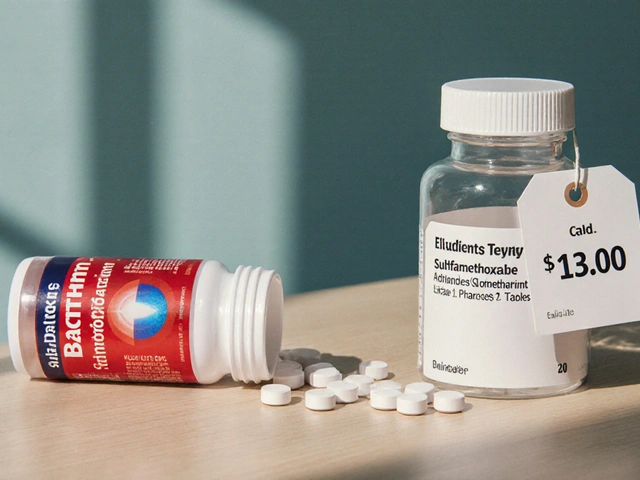- Ramipril is an ACE inhibitor that cuts the risk of heart attacks, strokes, and cardiovascular death in high‑risk patients.
- It blocks the renin‑angiotensin‑aldosterone system, lowering blood pressure and easing heart strain.
- Large trials such as HOPE and EUROPA proved its benefit for both primary and secondary prevention of cardiovascular disease.
- Usual starting dose is 2.5-5mg once daily; common side effects include cough, high potassium, and rare angioedema.
Ramipril is an ACE inhibitor prescribed to lower blood pressure and reduce the risk of cardiovascular events.
ACE inhibitor is a drug class that blocks the angiotensin‑converting enzyme, preventing the formation of the potent vasoconstrictor angiotensinII.
Angiotensin‑converting enzyme (ACE) converts angiotensin I to angiotensin II, a key mediator of blood‑vessel narrowing and fluid retention.
Renin‑angiotensin‑aldosterone system (RAAS) is a hormonal cascade that regulates blood volume, vascular tone, and sodium balance.
Hypertension is a chronic elevation of arterial pressure that strains the heart and arteries.
Cardiovascular disease covers conditions such as coronary artery disease, stroke, and heart failure caused by impaired blood flow.
Losartan is an angiotensin‑II receptor blocker (ARB) that offers a similar blood‑pressure‑lowering effect without inhibiting ACE.
Enalapril is a widely used ACE inhibitor that shares the same mechanism as Ramipril but differs in dosing and half‑life.
How Ramipril Lowers Cardiovascular Risk
Ramipril binds to the active site of ACE, stopping the conversion of angiotensin I into angiotensin II. With less angiotensinII circulating, blood vessels relax, peripheral resistance falls, and the heart does not have to pump as hard. The drug also reduces aldosterone secretion, which curbs sodium and water retention, further easing pressure on the cardiovascular system.
Beyond blood‑pressure control, Ramipril improves the health of the lining of blood vessels (endothelium), lowers the thickness of the left‑ventricular wall, and reduces inflammatory markers such as C‑reactive protein. These effects together translate into fewer plaque ruptures, fewer clot formations, and ultimately lower rates of heart attacks and strokes.
Key Clinical Trials That Shaped the Evidence
The most influential study is the Heart Outcomes Prevention Evaluation (HOPE) trial, which enrolled over9,300 patients with cardiovascular risk factors but no overt heart disease. Participants taking Ramipril saw a 22% reduction in the combined endpoint of myocardial infarction, stroke, or cardiovascular death compared with placebo.
HOPE‑2 extended these findings to patients with diabetes, confirming a 20% drop in major cardiovascular events when Ramipril was added to standard care. In the European trial of Ramipril in Angina (EUROPA), 9,400 patients with stable coronary artery disease received either Ramipril (10mg daily) or placebo; the drug cut cardiovascular death by 23% and the need for revascularisation by 15%.
Other studies such as PEACE (Ramipril in stable coronary disease) and ONTARGET (comparing Ramipril to the ARB telmisartan) reinforce that ACE inhibition delivers consistent risk reduction across different patient groups, ages, and baseline blood‑pressure levels.
Ramipril vs. Other ACE Inhibitors and ARBs
| Drug | Class | Typical Daily Dose (mg) | Key Trial | Primary Benefit |
|---|---|---|---|---|
| Ramipril | ACE inhibitor | 2.5-10 | HOPE, EUROPA | Strong evidence for primary and secondary prevention |
| Enalapril | ACE inhibitor | 5-20 | ONTARGET | Effective in heart failure; longer half‑life |
| Losartan | Angiotensin‑II receptor blocker (ARB) | 25-100 | ELITE II | Similar BP control with lower cough risk |
All three agents lower blood pressure, but Ramipril’s track record in large outcome trials makes it the go‑to choice when the goal is to prevent heart attacks or strokes. Losartan is useful for patients who cannot tolerate the ACE‑inhibitor‑related cough, while Enalapril offers a convenient twice‑daily regimen for certain heart‑failure patients.
Patients Who Benefit Most
Guidelines from major cardiology societies recommend Ramipril for anyone with one or more of the following risk factors:
- Established coronary artery disease (history of MI, stable angina, or prior revascularisation)
- Ischemic stroke or transient ischemic attack
- Peripheral artery disease
- Diabetes mellitus with additional risk markers (elevated albuminuria, high LDL)
- Left‑ventricular hypertrophy detected on ECG or imaging
Even patients with only stage1 hypertension (130-139/80-89mmHg) and a high calculated 10‑year cardiovascular risk (>10%) can gain protective benefits from low‑dose Ramipril, as shown in the HOPE trial subgroup analysis.

Safety Profile and What to Watch For
Ramipril is generally well tolerated. The most common adverse effect is a dry cough, reported in about 5‑10% of users. If the cough becomes bothersome, switching to an ARB such as Losartan can resolve it.
Serum potassium should be checked within 2weeks of initiation and after any dose change, especially in patients on potassium‑sparing diuretics or supplements. Hyperkalaemia (>5.5mmol/L) occurs in roughly 2% of cases.
Rare but serious reactions include angio‑edema (swelling of the lips, tongue, or airway) and acute kidney injury in patients with bilateral renal artery stenosis. Baseline creatinine and eGFR should be measured before starting therapy and monitored periodically.
Practical Tips for Using Ramipril
- Start with 2.5mg once daily for most patients; titrate to 5mg after 2weeks if blood pressure remains above target.
- Take the medication at the same time each day, preferably in the morning, with or without food.
- Combine with a thiazide diuretic if additional blood‑pressure lowering is needed, but watch potassium levels.
- Educate patients to report any facial swelling, tongue swelling, or difficulty breathing immediately.
- Encourage adherence by linking the dose to a daily habit (e.g., after brushing teeth).
Related Concepts to Explore
Understanding the full picture of heart‑disease prevention involves a few companion topics:
- Blood‑pressure targets - current recommendations aim for <130/80mmHg in most high‑risk individuals.
- Statin therapy - statins work alongside ACE inhibitors to lower LDL cholesterol and further cut event rates.
- Lifestyle modifications - regular aerobic exercise, a Mediterranean‑style diet, and smoking cessation remain essential.
- Kidney function monitoring - renal health directly influences drug choice and dosing.
- Patient education tools - apps that track medication adherence improve long‑term outcomes.
Frequently Asked Questions
Can Ramipril prevent heart attacks?
Yes. In the HOPE and EUROPA trials, Ramipril reduced the incidence of myocardial infarction by about 20% compared with placebo, confirming its role in primary and secondary prevention of heart attacks.
What dose of Ramipril is recommended for cardiovascular prevention?
Guidelines suggest starting at 2.5mg once daily. If blood pressure is not at target after 2weeks, the dose can be increased to 5mg, with a maximum of 10mg daily for most adults.
How does Ramipril differ from Losartan?
Ramipril blocks ACE, preventing the formation of angiotensinII, while Losartan blocks the angiotensinII receptor. Both lower blood pressure, but Losartan is less likely to cause cough and is the preferred switch if an ACE‑inhibitor-induced cough emerges.
What are the most common side effects of Ramipril?
The dry cough occurs in 5‑10% of users. Elevated potassium and a slight increase in serum creatinine are also common. Rarely, angio‑edema can develop and requires immediate medical attention.
Is Ramipril safe for people with chronic kidney disease?
Ramipril can be used in patients with mild‑to‑moderate chronic kidney disease, but baseline kidney function should be measured, and serum creatinine and potassium should be checked after starting therapy and after any dose change.
Can I take Ramipril together with a statin?
Yes. There are no significant drug‑drug interactions between Ramipril and commonly prescribed statins such as atorvastatin or rosuvastatin. Combining them is often recommended for comprehensive cardiovascular risk reduction.
What should I do if I miss a dose of Ramipril?
Take the missed dose as soon as you remember unless it is almost time for the next dose. In that case, skip the missed dose and resume your regular schedule. Do not double‑dose.








David McClone September 21, 2025
Oh great, another miracle pill that magically stops heart attacks while you forget to take your meds.
Abigail Lynch September 30, 2025
I’ve been reading up on Ramipril and I can’t shake the feeling that big pharma is feeding us a cocktail of sugar‑coated promises.
They tell us it slashes the risk of MI and stroke, but do they ever mention the hidden agenda?
The mechanism, they say, is simple: block ACE, lower angiotensin II, relax vessels.
Yet every time I see a new trial, I wonder who paid for the data.
The HOPE trial sounds impressive, but the sponsor list reads like a who’s‑who of pharmaceutical giants.
And then there’s the side‑effect profile – cough, hyperkalaemia, rashes – all conveniently buried in fine print.
Imagine a world where they actually gave us the raw numbers without the glossy PR spin.
I’m also concerned about the blanket recommendation for anyone with a 10‑year risk over 10 %.
That threshold feels like a fishing line cast into the population to reel in more prescriptions.
The dosage guidelines start low, which is nice, but the titration schedule feels like a maze.
“Take it in the morning with or without food” – what if my morning coffee interferes with absorption?
Some patients swear by it, but I’ve heard whispers of angioedema cases that never see the light of day.
The comparative tables show Ramipril beating Enalapril and Losartan, yet the data is cherry‑picked.
If you’re truly caring about heart‑disease prevention, you should be looking at lifestyle changes too.
Still, I can’t deny that the reduction in cardiovascular death is statistically significant.
Bottom line: the drug does what it promises on paper, but the corporate narrative around it makes me skeptical.
Jessica Romero October 9, 2025
From a pathophysiological standpoint, ramipril’s inhibition of the renin‑angiotensin‑aldosterone system yields a cascade of hemodynamic benefits that are hard to ignore.
By attenuating angiotensin II synthesis, we see a measurable decrement in afterload, which in turn mitigates left‑ventricular hypertrophy progression.
The drug also exerts favorable effects on endothelial nitric oxide bioavailability, contributing to improved vasomotor tone.
Clinical trial data, particularly from HOPE and EUROPA, underscore a statistically significant relative risk reduction in composite cardiovascular endpoints.
It’s noteworthy that the magnitude of benefit persists across subgroups stratified by baseline systolic pressure, age, and comorbid diabetes.
When juxtaposed with other ACE inhibitors like enalapril, ramipril demonstrates a comparable safety profile, albeit with a slightly lower incidence of dose‑related hypotension.
The pharmacokinetic profile, featuring a prodrug conversion to the active metabolite, affords once‑daily dosing convenience, enhancing adherence potential.
Renal function monitoring remains pivotal, especially in patients with concomitant potassium‑sparing diuretics, to preempt hyperkalaemia.
Moreover, the rare but serious adverse event of angioedema mandates vigilant patient education regarding early symptom recognition.
From a guideline perspective, major cardiology societies assign a Class I recommendation for ACE inhibition in secondary prevention cohorts.
Nevertheless, it is imperative to integrate pharmacotherapy with lifestyle modifications for holistic cardiovascular risk mitigation.
In summary, ramipril stands as a robust therapeutic option, provided clinicians tailor therapy to individual patient risk‑benefit calculus.
Michele Radford October 18, 2025
Honestly, anyone who glosses over the cough side‑effect as “minor” is just enabling patients to suffer in silence.
Mangal DUTT Sharma October 27, 2025
Reading through the mechanisms, I can’t help but feel a sense of awe at how a single molecule can influence multiple pathways simultaneously 😊.
When ramipril blocks ACE, the downstream reduction in angiotensin II not only lowers blood pressure but also diminishes aldosterone‑mediated sodium retention, which is crucial for patients with fluid overload 💧.
The improvement in endothelial function, often reflected by increased flow‑mediated dilation, adds another layer of cardiovascular protection that many studies, like HOPE‑2, have highlighted.
I’ve seen firsthand in clinic how patients transitioning from a high‑dose diuretic regimen to a modest ramipril dose report better energy levels and fewer nocturnal bathroom trips 🌙.
Of course, we must remain vigilant about monitoring serum potassium, especially when patients are also on potassium‑rich diets or supplements 🥑.
The incidence of a dry cough, while bothersome, is often manageable by switching to an ARB, but the trade‑off in efficacy for primary prevention is still up for debate.
Renal function checks at baseline and periodic intervals are non‑negotiable, particularly in the elderly with pre‑existing CKD 🩺.
What truly impresses me is the consistency of benefit across diverse populations, from post‑MI patients to those with merely elevated calculated risk scores.
In practice, coupling ramipril with a thiazide diuretic can achieve synergistic blood pressure reductions, though one must tread carefully to avoid excessive electrolyte disturbances.
Overall, the drug’s pharmacodynamic profile aligns well with the goal of comprehensive cardiovascular risk reduction, making it a staple in many treatment algorithms 🏥.
Gracee Taylor November 5, 2025
Ramipril’s track record in large outcome trials makes it a reliable choice for clinicians aiming to lower both blood pressure and cardiovascular events.
Leslie Woods November 14, 2025
Ramipril works by blocking ACE and lowering blood pressure
Manish Singh November 23, 2025
Yeah i totally agree with the basic idea but theres a few more things to keep in mind
First the drug also helps with reducing the left ventricular wall thickness which is a big win for people with hypertrophy
Second you have to check kidney function before starting especially if the patient has a history of renal artery stenosis
Also dont forget to watch for high potassium levels if they are also on a potassium sparing diuretic
Overall its a solid medication but like any therapy follows the rule of careful monitoring and patient education.
Dipak Pawar December 2, 2025
The pharmacological nuance of ramipril lies in its prodrug nature, wherein the esterified moiety undergoes hepatic hydrolysis to yield the active dipeptide that potently inhibits angiotensin‑converting enzyme.
This inhibition leads to a downstream attenuation of the renin‑angiotensin‑aldosterone cascade, thereby modulating both systemic vascular resistance and intravascular fluid homeostasis.
From a hemodynamic perspective, the resultant vasodilation precipitates a reduction in mean arterial pressure, which translates into decreased myocardial oxygen demand and mitigated shear stress on arterial endothelium.
Clinical evidence, particularly from the HOPE and EUROPA trials, demonstrates a statistically robust hazard ratio reduction for composite cardiovascular endpoints, underscoring the drug’s efficacy in both primary and secondary prevention paradigms.
Moreover, the drug’s half‑life, mediated by its active metabolite, facilitates once‑daily dosing schedules that align with adherence optimization strategies in outpatient care.
Nevertheless, clinicians must remain vigilant regarding adverse events such as ACE‑inhibitor–induced cough, hyperkalemia, and the rare but severe angioedema, which necessitates prompt identification and therapeutic substitution when indicated.
Renal function surveillance, especially in patients with concomitant nephrotoxic agents or pre‑existing chronic kidney disease, is imperative to preempt iatrogenic acute kidney injury.
In comparative pharmacotherapy, while ARBs like losartan offer a lower cough incidence, the extensive outcome data favoring ramipril in preventing myocardial infarction provides a compelling rationale for its preferential use in high‑risk cohorts.
Ultimately, the integration of ramipril into a multifactorial risk mitigation regimen-encompassing lipid management, glycemic control, and lifestyle interventions-optimizes cardiovascular prognostication.
Jonathan Alvarenga December 11, 2025
While the academic prose sounds impressive, the real‑world applicability often falls short due to the one‑size‑fits‑all dosing algorithms that ignore patient heterogeneity.
Most of the cited trials enrolled a selective cohort with relatively preserved renal function, thereby limiting extrapolation to the frail elderly population that you see every day in practice.
The emphasis on hazard ratios masks the absolute risk reduction, which, for many low‑to‑moderate risk individuals, translates into a number needed to treat that is clinically questionable.
Furthermore, the cough side‑effect, dismissed as “minor,” leads to poor adherence and subsequent loss of any potential benefit, a factor that trialists seldom account for in their intention‑to‑treat analyses.
The purported superiority over ARBs is often a function of trial sponsorship rather than head‑to‑head comparative effectiveness, and meta‑analyses have shown parity in major cardiovascular outcomes.
In addition, the requirement for routine potassium and creatinine monitoring adds a layer of complexity that strains primary care resources, especially in underserved settings.
Thus, while ramipril remains a staple on guideline tables, clinicians should adopt a more nuanced, patient‑centered approach rather than reflexively prescribing based on headline trial results.
Jim McDermott December 20, 2025
Ramipril is a solid option for blood pressure control, and its proven efficacy in reducing heart attacks makes it a go‑to for many doctors.